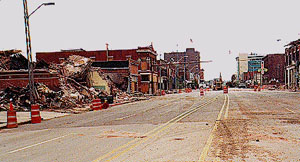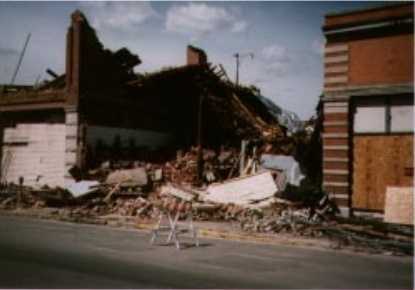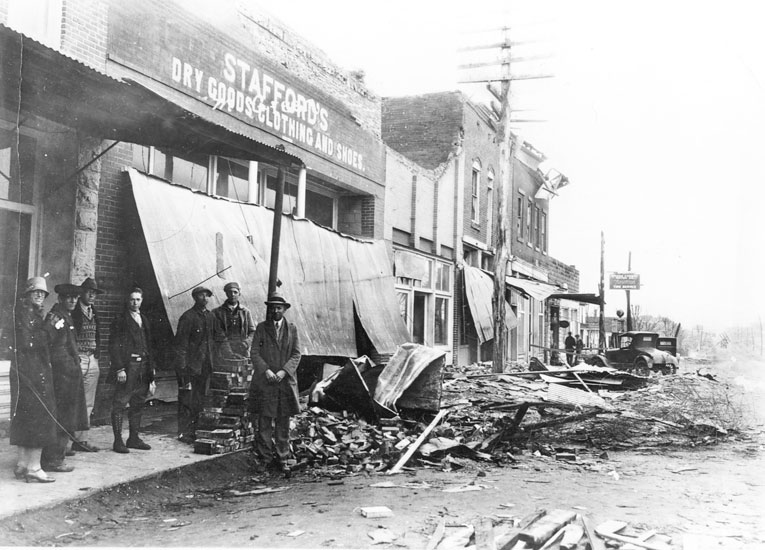By Dr. Curtis Varnell
Huge oaks, three feet or more in diameter, shattered like so many straws, laying in piles resembling the old pick up sticks game. Crushed cars, collapsed buildings, sheet metal, clothes, and the turf from the high school football field strewn in ditches, tops of trees, and piles of rubbish. Your heart breaks as you see a small child’s tricycle and then a baby bed standing in the middle of the desolation. People walked in the midst of the wreckage, a resigned look on their faces as they searched for remains of their lives that existed prior to the tornado. Wynne resembled a war zone, the result of the tornado that roared through the city on March 31, 23 killing four people and injuring dozens. Hours earlier, tornadoes spawned from the same cell had hit western Little Rock. One of the worst tornadoes to hit an Arkansas urban area, unfortunately it was not the first nor will it be the last.



Tornadoes are the most frequent and most destructive natural hazard faced by Arkansans. Earthquakes, such as the New Madrid earthquake, occur only in intervals of two-hundred or more years but tornadoes are a regular occurrence. They appear to strike almost at random and seemingly can hit virtually any area in the state. While Arkansas in not normally considered a part of the tornado alley just to the west of our state, we have suffered from way too many violent and destructive episodes. Some of the most recent data indicate that, although rural and with a small population, we rank only behind Mississippi in number of fatalities per 100,000 populations.
During the spring months, especially April, warm air rises from the Gulf and clashes overhead with the cold air from the poles. Rising winds create vortices of air that began to move across the landscape at speeds that can exceed 300 mph. Any place in the path of winds at that speed are going to suffer destruction. The largest outbreak ever to hit the state was in Jan. of 1999 and those 56 tornadoes resulted in untold destruction and in multiple deaths across the state.
One of the worst tornadoes in my lifetime occurred in Greenwood in 1968. Lasting only 4 minutes, the F4 tornado tore through the middle of town and left 14 dead and 270 injured. Most of Greenwood was reduced to kindling and rubble. Four-hundred homes and over sixty business were destroyed and it took the city years to recover.
In growing up, an elderly gentleman described the tornado that struck his home in Logan County. The home he lived in was completely destroyed, his parents and every sibling were killed, and he was found barely alive in a tree yards from his former home. Taken to Paris for medical assistance, there wasn’t room enough for all the injured in the hospital so he spent days with others in the courthouse which provided temporary shelter.
My eldest son, Jamie, was caught in Fort Smith during the 1996 tornado that destroyed a portion of historic downtown. Traveling in the downtown area as it hit, the wind whipped the vehicle they were in sideways as roofing, sheet metal, and debris rained onto the car. Walls of building built of brick and concrete tumbled into the street and electric wires dangled, shooting sparks into the air as all lights went out. In minutes, it was over but the city would never be the same.
Arkansas people are resilient and work together to overcome such disasters. Relief groups from the Salvation Army, Red Cross, Shepherds, and even groups from as far away as Oregon were in Wynne to assist. As our group gathered outside the hotel at Forrest City to travel to Marvell to assist the schools there, we joined hands for prayer with relief groups from all over the country that were going the few miles north to Wynne. Schools, businesses, and homes can be rebuilt, the memories and fears of the people involved take much longer to erase.

![476295_web_Greenwood_Tornado_Anniv_2[1]](https://residentnewsnetwork.com/wp-content/uploads/2023/04/476295_web_Greenwood_Tornado_Anniv_21.jpg)




